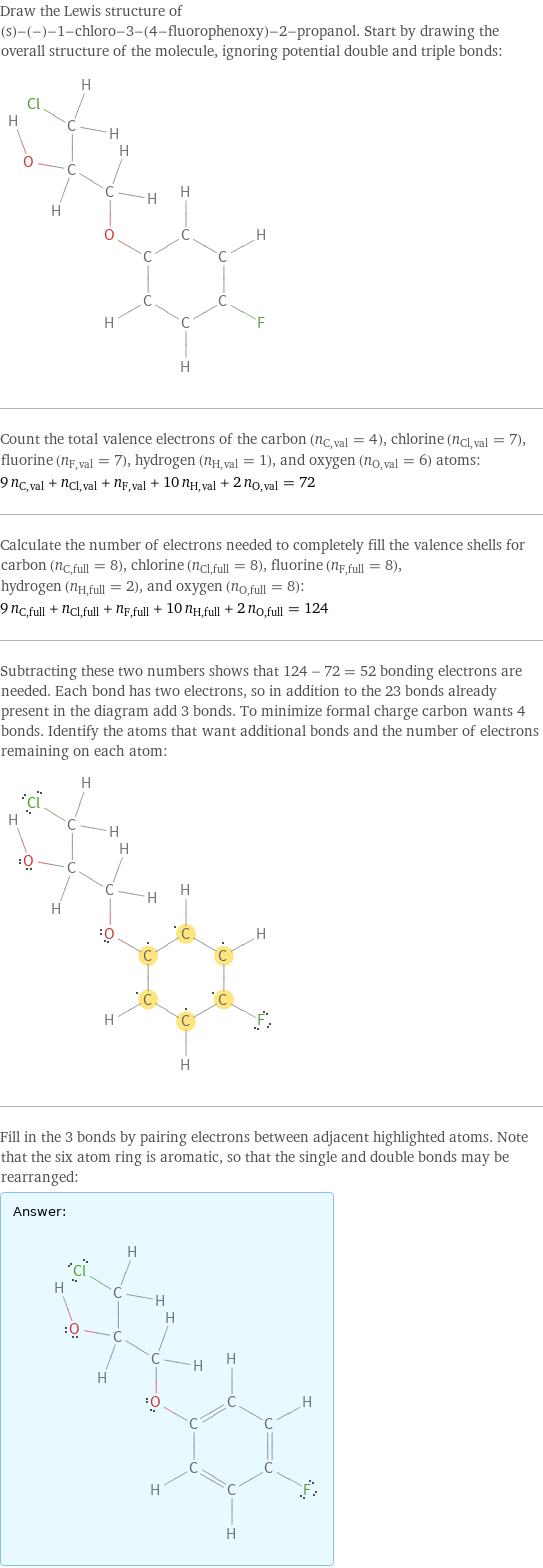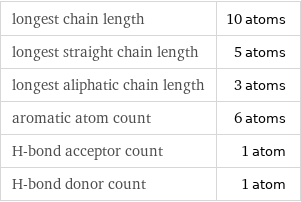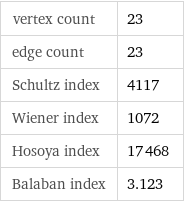Input interpretation

(s)-(-)-1-chloro-3-(4-fluorophenoxy)-2-propanol
Basic properties
O)F InChI identifier | InChI=1/C9H10ClFO2/c10-5-8(12)6-13-9-3-1-7(11)2-4-9/h1-4, 8, 12H, 5-6H2/t8-/m1/s1 InChI key | OSIKOYZBGUHWAB-MRVPVSSYSA-N](../image_source/78e69b12b1edc0bcd4af1c098758cb25.png)
molar mass | 204.6 g/mol formula | C_9H_10ClFO_2 empirical formula | Cl_C_9O_2F_H_10 SMILES identifier | C1=C(C=CC(=C1)OC[C@@H](CCl)O)F InChI identifier | InChI=1/C9H10ClFO2/c10-5-8(12)6-13-9-3-1-7(11)2-4-9/h1-4, 8, 12H, 5-6H2/t8-/m1/s1 InChI key | OSIKOYZBGUHWAB-MRVPVSSYSA-N
Lewis structure

Draw the Lewis structure of (s)-(-)-1-chloro-3-(4-fluorophenoxy)-2-propanol. Start by drawing the overall structure of the molecule, ignoring potential double and triple bonds: Count the total valence electrons of the carbon (n_C, val = 4), chlorine (n_Cl, val = 7), fluorine (n_F, val = 7), hydrogen (n_H, val = 1), and oxygen (n_O, val = 6) atoms: 9 n_C, val + n_Cl, val + n_F, val + 10 n_H, val + 2 n_O, val = 72 Calculate the number of electrons needed to completely fill the valence shells for carbon (n_C, full = 8), chlorine (n_Cl, full = 8), fluorine (n_F, full = 8), hydrogen (n_H, full = 2), and oxygen (n_O, full = 8): 9 n_C, full + n_Cl, full + n_F, full + 10 n_H, full + 2 n_O, full = 124 Subtracting these two numbers shows that 124 - 72 = 52 bonding electrons are needed. Each bond has two electrons, so in addition to the 23 bonds already present in the diagram add 3 bonds. To minimize formal charge carbon wants 4 bonds. Identify the atoms that want additional bonds and the number of electrons remaining on each atom: Fill in the 3 bonds by pairing electrons between adjacent highlighted atoms. Note that the six atom ring is aromatic, so that the single and double bonds may be rearranged: Answer: | |
Estimated thermodynamic properties

melting point | 55.54 °C boiling point | 314.7 °C critical temperature | 781.6 K critical pressure | 3.21 MPa critical volume | 529.5 cm^3/mol molar heat of vaporization | 60.8 kJ/mol molar heat of fusion | 21.74 kJ/mol molar enthalpy | -505.6 kJ/mol molar free energy | -323.3 kJ/mol (computed using the Joback method)
Units

Quantitative molecular descriptors

longest chain length | 10 atoms longest straight chain length | 5 atoms longest aliphatic chain length | 3 atoms aromatic atom count | 6 atoms H-bond acceptor count | 1 atom H-bond donor count | 1 atom
Elemental composition

Find the elemental composition for (s)-(-)-1-chloro-3-(4-fluorophenoxy)-2-propanol in terms of the atom and mass percents: atom percent = N_i/N_atoms × 100% mass percent = (N_im_i)/m × 100% Plan: • Write the chemical formula and gather atomic masses from the periodic table. • Determine values for N_i, m_i, N_atoms and m using these items. • Finally, compute the percents and check the results. Write the chemical formula: C_9H_10ClFO_2 Use the chemical formula to count the number of atoms, N_i, for each element and find the total number of atoms, N_atoms, per molecule: | number of atoms Cl (chlorine) | 1 C (carbon) | 9 O (oxygen) | 2 F (fluorine) | 1 H (hydrogen) | 10 N_atoms = 1 + 9 + 2 + 1 + 10 = 23 Divide each N_i by N_atoms to calculate atom fractions. Then use the property that atom fractions must sum to one to check the work: | number of atoms | atom fraction Cl (chlorine) | 1 | 1/23 C (carbon) | 9 | 9/23 O (oxygen) | 2 | 2/23 F (fluorine) | 1 | 1/23 H (hydrogen) | 10 | 10/23 Check: 1/23 + 9/23 + 2/23 + 1/23 + 10/23 = 1 Compute atom percents using the atom fractions: | number of atoms | atom percent Cl (chlorine) | 1 | 1/23 × 100% = 4.35% C (carbon) | 9 | 9/23 × 100% = 39.1% O (oxygen) | 2 | 2/23 × 100% = 8.70% F (fluorine) | 1 | 1/23 × 100% = 4.35% H (hydrogen) | 10 | 10/23 × 100% = 43.5% Look up the atomic mass, m_i, in unified atomic mass units, u, for each element in the periodic table: | number of atoms | atom percent | atomic mass/u Cl (chlorine) | 1 | 4.35% | 35.45 C (carbon) | 9 | 39.1% | 12.011 O (oxygen) | 2 | 8.70% | 15.999 F (fluorine) | 1 | 4.35% | 18.998403163 H (hydrogen) | 10 | 43.5% | 1.008 Multiply N_i by m_i to compute the mass for each element. Then sum those values to compute the molecular mass, m: | number of atoms | atom percent | atomic mass/u | mass/u Cl (chlorine) | 1 | 4.35% | 35.45 | 1 × 35.45 = 35.45 C (carbon) | 9 | 39.1% | 12.011 | 9 × 12.011 = 108.099 O (oxygen) | 2 | 8.70% | 15.999 | 2 × 15.999 = 31.998 F (fluorine) | 1 | 4.35% | 18.998403163 | 1 × 18.998403163 = 18.998403163 H (hydrogen) | 10 | 43.5% | 1.008 | 10 × 1.008 = 10.080 m = 35.45 u + 108.099 u + 31.998 u + 18.998403163 u + 10.080 u = 204.625403163 u Divide the mass for each element by m to calculate mass fractions. Then use the property that mass fractions must sum to one to check the work: | number of atoms | atom percent | mass fraction Cl (chlorine) | 1 | 4.35% | 35.45/204.625403163 C (carbon) | 9 | 39.1% | 108.099/204.625403163 O (oxygen) | 2 | 8.70% | 31.998/204.625403163 F (fluorine) | 1 | 4.35% | 18.998403163/204.625403163 H (hydrogen) | 10 | 43.5% | 10.080/204.625403163 Check: 35.45/204.625403163 + 108.099/204.625403163 + 31.998/204.625403163 + 18.998403163/204.625403163 + 10.080/204.625403163 = 1 Compute mass percents using the mass fractions: Answer: | | | number of atoms | atom percent | mass percent Cl (chlorine) | 1 | 4.35% | 35.45/204.625403163 × 100% = 17.32% C (carbon) | 9 | 39.1% | 108.099/204.625403163 × 100% = 52.83% O (oxygen) | 2 | 8.70% | 31.998/204.625403163 × 100% = 15.64% F (fluorine) | 1 | 4.35% | 18.998403163/204.625403163 × 100% = 9.284% H (hydrogen) | 10 | 43.5% | 10.080/204.625403163 × 100% = 4.926%
Elemental oxidation states

The first step in finding the oxidation states (or oxidation numbers) in (s)-(-)-1-chloro-3-(4-fluorophenoxy)-2-propanol is to draw the structure diagram. Next set every oxidation number equal to the atom's formal charge: In (s)-(-)-1-chloro-3-(4-fluorophenoxy)-2-propanol hydrogen is not bonded to a metal with lower electronegativity, so it will have an oxidation state of +1. Any element bonded to hydrogen gains the bonding electrons, decreasing their oxidation state by 1 for every bond: With hydrogen out of the way, look at the remaining bonds. There are 1 carbon-chlorine bond, 1 carbon-fluorine bond, 3 carbon-oxygen bonds, and 8 carbon-carbon bonds. For each of these bonds, assign the bonding electrons to the most electronegative element. First examine the carbon-chlorine bond: element | electronegativity (Pauling scale) | C | 2.55 | Cl | 3.16 | | | Since chlorine is more electronegative than carbon, the electrons in this bond will go to chlorine. Decrease the oxidation number for chlorine (by 1 for single bonds, 2 for double bonds, and 3 for triple bonds), and increase the oxidation number for carbon accordingly: Next look at the carbon-fluorine bond: element | electronegativity (Pauling scale) | C | 2.55 | F | 3.98 | | | Since fluorine is more electronegative than carbon, the electrons in this bond will go to fluorine: Next look at the carbon-oxygen bonds: element | electronegativity (Pauling scale) | C | 2.55 | O | 3.44 | | | Since oxygen is more electronegative than carbon, the electrons in these bonds will go to oxygen: Next look at the carbon-carbon bonds: element | electronegativity (Pauling scale) | C | 2.55 | C | 2.55 | | | Since these elements are the same the bonding electrons are shared equally, and there is no change to the oxidation states: Now summarize the results: Answer: | | oxidation state | element | count -2 | O (oxygen) | 2 -1 | C (carbon) | 6 | Cl (chlorine) | 1 | F (fluorine) | 1 0 | C (carbon) | 1 +1 | C (carbon) | 2 | H (hydrogen) | 10
Orbital hybridization

First draw the structure diagram for (s)-(-)-1-chloro-3-(4-fluorophenoxy)-2-propanol, and for every non-hydrogen atom, count the σ-bonds. Note that double and triple bonds consist of one σ-bond together with one or two π-bonds: Identify those atoms with lone pairs: Find the steric number by adding the lone pair count to the number of σ-bonds: Consult the following chart to determine the hybridization from the steric number: steric number | hybridization 2 | sp 3 | sp^2 4 | sp^3 5 | dsp^3 6 | d^2sp^3 7 | d^3sp^3 Assign the provisional hybridization based on the table: Next identify any sp^3 atoms with lone pair electrons which can participate in a conjugated π-bond system. These atoms can lower their energy by placing a lone pair in a unhybridized p orbital to maximize overlap with the neighboring π-bonds. Note that halogens and elements from the third period and below do not engage in bond conjugation, except in the case of aromaticity: Adjust the provisional hybridizations to arrive at the result: Answer: | |
Topological indices

vertex count | 23 edge count | 23 Schultz index | 4117 Wiener index | 1072 Hosoya index | 17468 Balaban index | 3.123